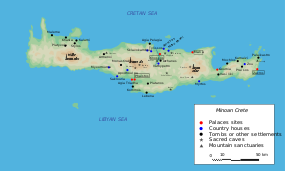Phaistos
 View of Phaistos | |
 Map of Minoan Crete | |
| Alternative name | Phaestus |
|---|---|
| Location | Faistos, Heraklion, Crete, Greece |
| Region | The eastern point of a ridge overlooking Messara Plain to the east |
| Coordinates | 35°03′05″N 24°48′49″E / 35.05139°N 24.81361°ECoordinates: 35°03′05″N 24°48′49″E / 35.05139°N 24.81361°E |
| Type | Palace complex and city |
| Part of | The state ruled from Knosses under a monarchy symbolized by "King Minos" |
| Area | 8,400 m2 (90,000 sq ft)[2] for the palace. The city covered the hill and a few km into the valley below. |
| History | |
| Builder | Unknown |
| Material | Trimmed blocks of limestone and alabaster, mud-brick, rubble, wood |
| Founded | The first settlement dates to the Late Neolithic starting about 3000 BC. The first palace dates to about 1850 BC.[3] New palace dates to around 1700 BC[4] |
| Periods | Late Neolithic to Late Bronze Age. The first palace was built at the start of Middle Minoan |
| Cultures | Minoan |
| Satellite of | The kingdom centered at Knossos |
| Associated with | In the Bronze Age, people of unknown ethnicity now called Minoans |
| Site notes | |
| Excavation dates | 1874, Federico Halbherr alone 1900–1904, 1950–1971, Italian School of Archaeology at Athens Since 2007, the Phaistos Project |
| Archaeologists | 1900–1904, Federico Halbherr and Luigi Pernier 1950–1972, Doro Levi |
| Condition | Current interventions are tamped soil, stone walkways, hand rails, lightly roofed areas, with more planned.[2] |
| Management | 23rd Ephorate of Prehistoric and Classical Antiquitites; Italian School of Archaeology at Athens; University of Salerno, Department of Cultural Heritage Sciences |
| Public access | Yes |
| Website | "Phaistos". |
Phaistos (Greek: Φαιστός, pronounced [feˈstos]; Ancient Greek: Φαιστός, pronounced [pʰai̯stós], Minoan: PA-I-TO?[1]), also transliterated as Phaestos, Festos and Latin Phaestus, is a Bronze Age archaeological site at modern Faistos, a municipality in south central Crete. Ancient Phaistos was located about 5.6 km (3.5 mi) east of the Mediterranean Sea and 62 km (39 mi) south of Heraklion, the second largest city of Minoan Crete.[5] The name Phaistos survives from ancient Greek references to a city in Crete of that name at or near the current ruins.
The name is substantiated by the coins of the classical city. They display motifs such as Europa sitting on a bull, Talos with wings, Heracles without beard and being crowned, and Zeus in the form of a naked youth sitting on a tree. On either the obverse or the reverse the name of the city, or its abbreviation, is inscribed, such as ΦΑΙΣ or ΦΑΙΣΤΙ, for Phaistos or Phaistios ("Phaistian" adjective) written either right-to-left or left-to-right.[6] These few dozen coins were acquired by collectors from uncontrolled contexts. They give no information on the location of Phaistos.[citation needed]
Archaeology[]
Phaistos was located by Thomas Abel Brimage Spratt, commander of the Spitfire, a paddle steamer, in the Mediterranean Survey of 1853, which described the topography, settlements and monuments of Crete.[7] Spratt followed the directions of Strabo, who said:[8]
Of the three cities that were united under one metropolis by Minos, the third, which was Phaestus, was razed to the ground by the Gortynians; it is sixty stadia distant from Gortyn, twenty from the sea, and forty from the seaport Matalum; and the country is held by those who razed it.
The simple geometric problem posed by these distances from known points was solved with no difficulty by the survey. The location pinpointed was the eastern end of a hill, or ridge, rising from the middle of the Geropotamos river valley extending from the sea to the Messara Plain in an east–west direction. The hill was called Kastri ("fort", "small castle"). A military man, Spratt understood the significance of the location immediately:
I thus found that Phaestus had occupied the extremity of a ridge that divides the maritime plain of Debaki from the plain of the Messara, so as to command the narrow valley of communication.[9]
A village of 16 houses remained on the ridge, but the vestiges of fortification walls indicated a city had once existed there. A half-century later, after removing the houses, Federico Halbherr and his crew began to discover the remains of an extensive palace complex. As he had begun excavation before Arthur Evans at Knossos in 1900, he did not have the advantage of Evans' concepts of Minoan civilization nor the knowledge acquired after the decipherment of the Linear B syllabary by Michael Ventris. Excavation ended in 1904, to begin again after another half-century, in 1950. By this time it was understood that the palace had been constructed at the beginning of the Proto-Palace Period. After 1955 the place name,

